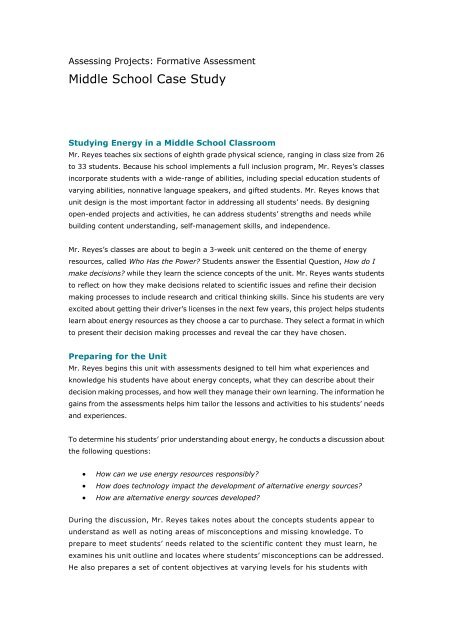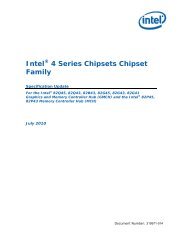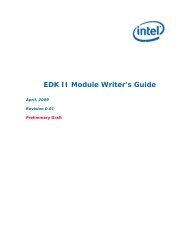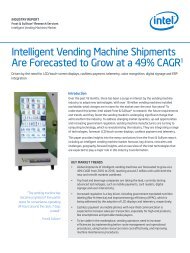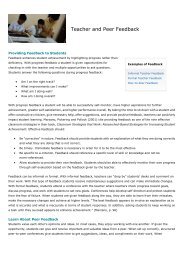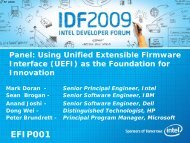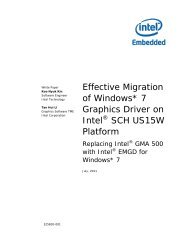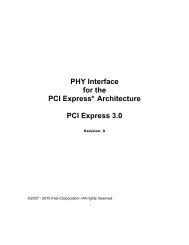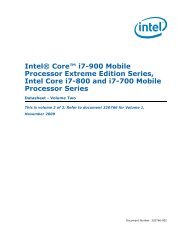Middle School Case Study - Intel
Middle School Case Study - Intel
Middle School Case Study - Intel
Create successful ePaper yourself
Turn your PDF publications into a flip-book with our unique Google optimized e-Paper software.
Assessing Projects: Formative Assessment<strong>Middle</strong> <strong>School</strong> <strong>Case</strong> <strong>Study</strong><strong>Study</strong>ing Energy in a <strong>Middle</strong> <strong>School</strong> ClassroomMr. Reyes teaches six sections of eighth grade physical science, ranging in class size from 26to 33 students. Because his school implements a full inclusion program, Mr. Reyes’s classesincorporate students with a wide-range of abilities, including special education students ofvarying abilities, nonnative language speakers, and gifted students. Mr. Reyes knows thatunit design is the most important factor in addressing all students’ needs. By designingopen-ended projects and activities, he can address students’ strengths and needs whilebuilding content understanding, self-management skills, and independence.Mr. Reyes’s classes are about to begin a 3-week unit centered on the theme of energyresources, called Who Has the Power? Students answer the Essential Question, How do Imake decisions? while they learn the science concepts of the unit. Mr. Reyes wants studentsto reflect on how they make decisions related to scientific issues and refine their decisionmaking processes to include research and critical thinking skills. Since his students are veryexcited about getting their driver’s licenses in the next few years, this project helps studentslearn about energy resources as they choose a car to purchase. They select a format in whichto present their decision making processes and reveal the car they have chosen.Preparing for the UnitMr. Reyes begins this unit with assessments designed to tell him what experiences andknowledge his students have about energy concepts, what they can describe about theirdecision making processes, and how well they manage their own learning. The information hegains from the assessments helps him tailor the lessons and activities to his students’ needsand experiences.To determine his students’ prior understanding about energy, he conducts a discussion aboutthe following questions:How can we use energy resources responsibly?How does technology impact the development of alternative energy sources?How are alternative energy sources developed?During the discussion, Mr. Reyes takes notes about the concepts students appear tounderstand as well as noting areas of misconceptions and missing knowledge. Toprepare to meet students’ needs related to the scientific content they must learn, heexamines his unit outline and locates where students’ misconceptions can be addressed.He also prepares a set of content objectives at varying levels for his students with
learning disabilities. He then shares the objectives with the special education teacherswho work with those students.Mr. Reyes asks students to respond to the following questions in their journals:How do I make decisions about science-related issues?How can I become a more independent learner?To obtain additional information about his students’ decision making processes, Mr.Reyes places them into small groups. Then, he asks them to discuss what decisions theymake about energy in their own lives and to justify their decisions. He notes the kinds ofthinking students demonstrate as well as their understanding of energy concepts. Heuses this information to help him prepare explicit instruction in the thinking skillsstudents need to complete the project.Students' Stories: Monica's and Justin's GoalsTo prepare his students to direct their learning, Mr. Reyes gives his students a self-directionchecklist. In the following excerpt from a sample checklist, Monica, a gifted student, analyzesher skills:I set goals that are possiblebut that challenge me andmake me work hard.I create reasonable timelinesand meet deadlines.I ask for and seriouslyconsider feedback fromdifferent sources.I learn from my mistakes andrarely make the samemistake twice.I usually do this. I had to learn sound-editing software to do mylast project, which was hard, but I did it. Sometimes, though, I tryto do things that are just too much for me, and I have to give up.I usually meet my deadlines. I only finish things late when I havecomputer problems.I don’t really like to ask people what they think of my work. Itsometimes makes me mad when people give me suggestions.I learn from my mistakes with computers, but I don’t alwaysimprove when I have problems with my fellow students.To help students become more in control of their learning during this project, Mr. Reyes asksstudents to look at their goals and reflection from the previous unit. He then instructsstudents to form a few new self-direction goals based on their answers to the checklist.Monica’s Goals1. I am going to ask Jenny for her opinion about my work because I respect her ideas,and I am going to consider what she says seriously and use some of her ideas.2. I am going to write in my journal every day about what progress I have made andwhat I am going to get accomplished the next day.
Justin’s Goals1. I will make sure I have my materials ready each day when class begins.2. I will slow down when I do my work and check over it before I turn it in to look forcareless errors.Mr. Reyes keeps a copy of his students’ self-direction goals and refers to the goals periodicallyas he conferences with his students. At the end of each project, students connect their goalsto the next unit, and they do a final reflection at the end of the year.Introducing the UnitIn the first part of the project, students research energy resources. Mr. Reyes chooses Websites for students to use for their research. He specifically chooses sites of various levels ofdifficulty so that all students start with the essential information. Then, more advancedstudents can move forward at their own pace. Mr. Reyes asks students to completeassessments on their content knowledge and record their responses as they work, so they,and he, can check their understanding.Mr. Reyes supplements the Web investigation with lessons and activities in class on thescientific concepts students need to complete the project. He uses questioning strategies toinvolve all levels of learners by preparing specific questions and discussion points addressingthe different levels of content objectives. He then carefully chooses which questions to ask tospecific students. By asking different levels of questions about the content, Mr. Reyes knowswhere he must make adjustments. Sometimes, Mr. Reyes designates peer tutors to helpstruggling classmates. This requires building a community atmosphere in which all studentsfeel safe learning from each other and respecting differences.For the final project, students conduct their own research and present the decision processesthey used to select the car of their choice. Before beginning this project, students create aproject plan. First, Mr. Reyes distributes a rubric delineating the criteria for the project. Next,he asks students for their ideas about how they plan to show that they have understood theimportant concepts and done their best work. He includes several of their ideas in the rubric.Mr. Reyes has noticed in the project plans of previous units that his students had troublebreaking down tasks into steps that could be accomplished in a class period or less. Becauseof this, they had difficulty monitoring their own progress effectively. For this project, Mr.Reyes takes some class time to explain and model how to break large tasks into smalleractivities, such as conduct research, narrow a topic, locate resources, and evaluate resources.He also holds small-group mini-lessons for interested students on using technology to createflowcharts, diagrams, and forms that can help track progress.As students work on their plans, Mr. Reyes conducts informal conferences with students.During the conferences, Mr. Reyes asks probing questions to help students refine their plansand address issues of scientific investigation. Mr. Reyes enlists the help of the support staff to
assist students with special needs in completing their plans, but all students are encouragedto complete as much of the plan as they can by themselves and with the help of their peers.Completing the ProjectStudents use the project rubric to self- and peer-assess their work as they create theirprojects. They consult with their groups at designated times to receive feedback and shareinformation. Responding constructively to peers takes practice, and Mr. Reyes develops aspecial lesson on providing, receiving, evaluating, and using feedback. While groups aremeeting, he observes each member, noting who needs help and extra instruction. Sometimes,he intervenes on the spot to model constructive feedback.Mr. Reyes knows that individual research does not guarantee that students will learn the corecurricular concepts for the unit. Therefore, Mr. Reyes supplements students’ project workwith a variety of student-centered activities to introduce and reinforce their learning aboutenergy, conservation, and the environment. He uses instructional time to model investigatingissues from a scientific perspective. He also demonstrates the kinds of skills students need toevaluate and interpret the kinds of data they will find in their research.Mr. Reyes uses an observation checklist to record students’ decision- making processes whilethey discuss their projects with their small groups. The following sample excerpt from thechecklist shows the kinds of information he collected about a group that includes Miranda, astudent with mild learning disabilities, and Lucas, a nonnative language speaker:Becky Lucas Miranda AlexSeeks multiple resourcesHas a nice variety,HavingUsing justHas a couplewith relevant informationincluding an interviewtrouble findingoneWeb sitewith a mechanicresources inmagazinearticlesSpanisharticlePredicts consequences ofMentioned cost forNot observedNotSaid hischoices on othersparentobservedfriendswould like itif he chose acertain carPredicts consequences ofMade chart comparingSaid usingNotSays if he’schoices on environment,cars’ greenhouse gasless fuel willobserveddriving fastrelated to consumption ofemissions andleave moreenough hefossil fuels and differentexplained how theyfuel for otherswon’t pollutekinds of pollutionwould effect climatethe airhereAfter students have done their research, made their decision about the car they would like tobuy, and reflected on their processes, they prepare to present their decision-making model.
Students should choose a format that lets them use their strengths and interests, and canbest illustrate their thinking. They may create flowcharts with statistical information andformulas, graphic representations, media presentations, writing, or performances.Mr. Reyes encourages students to include a component in their final project that challengesthem. He encourages Gina, a student who is a gifted writer, to write a script that will beperformed by friends. This allows her to use her strength and encourages her to take a risk byexperimenting with video technology. Lottie, who has severe learning disabilities, needs towork on her writing, but she loves to draw. Mr. Reyes suggests that she create a graphicnovel, which will give her practice on what she needs to work on while letting her do what sheenjoys.As students work individually on their projects and consult with their groups, Mr. Reyescirculates among students, observing their interactions and taking notes on their developingcontent knowledge. He also notes their collaboration, decision making, and self-directionskills. Using his notes, Mr. Reyes plans more in-depth instruction around energy concepts andprocess skills.Concluding the UnitMr. Reyes concludes the unit by asking students to write a detailed reflection about theirlearning about energy concepts, making decisions, and self-managing their own learning. Heanalyzes their answers to determine how individual students have learned the scientificconcepts and process skills. He writes notes to himself that he can use when addressing theneeds of all students in future units. Mr. Reyes uses three major strategies to ensure a unitaddresses all levels of learners in his classroom while teaching self-direction skils:He frequently asks students to do projects that address the curriculum he is requiredto teach but allows students to make some decisions about the content they learn,how they learn it, and how they show what they learned.While students are working, Mr. Reyes continually monitors progress so he canaddress misconceptions and misunderstandings immediately.He organizes his teaching around activities and instruction that provide students withthe skills they need to control their own learning.


